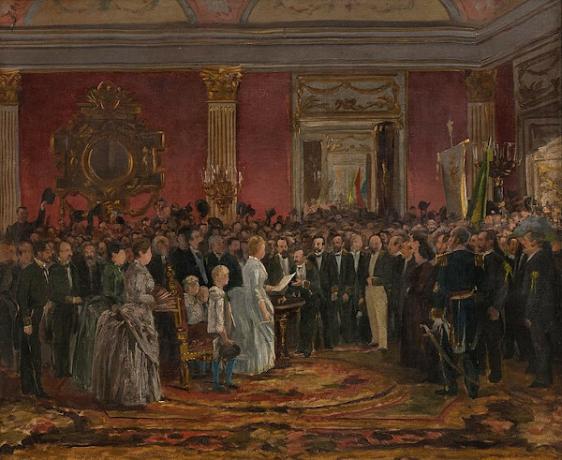Maria Firmina dos Reis is 19th century romantic writer from Maranhão, born on March 11, 1822 and died on November 11, 1917. In addition to being a writer, she was teacher, musician and creator of the first mixed school in Brazil. Her work consists of an Indianist novel called Gupeva (1861), the book of poetry corners by the sea (1871), the tale the slave (1887), in addition to musical compositions. Her best known book is Ursula, 1859 abolitionist novel.
Read too: Carolina Maria de Jesus – author of storage room
Biography of Maria Firmina dos Reis
The writer Maria Firmina dos Reis was born on March 11, 1822, in São Luís, in the state of Maranhão. For this reason, March 11, in her honor, is the Maranhense Woman's Day. Was mulatto, daughter of freed slave Leonor Felipa dos Reis and, possibly, of João Pedro Esteves, a wealthy man in the region. In addition to being a writer, she was a primary school teacher, from 1847 to 1881, and musician.
Ursula, her best known work, was published in 1859, with the
pseudonym ofa woman from Maranhão. From then on, Maria Firmina dos Reis started writing for several newspapers, in which she published some of her poems. She wrote a novel, a short story, published a book of poetry, as well as musical compositions.In 1880, she acquired the title of regal master. That same year, created a free school for children, but this institution did not last long. As it was a mixed school, the teacher's initiative at the time caused discontent in part of society in the village of Maçaricó. Thus, the writer and teacher went down in history as the founder, according to Zahidé Lupinacci Muzart (1939-2015), of the “first mixed school in the country”. Now retired, she continued teaching in Maçaricó for the children of farmers and farmers.
Died in November 11, 1917. According to José Nascimento Morais Filho (1882-1958), she was blind and poor. Her work was forgotten until 1962, when the historian Horácio de Almeida (1896-1983) put the writer in evidence. Recently, research on the life and work of Maria Firmina dos Reis and the dissemination of her name have intensified, and, little by little, the writer has been integrated into the brazilian literary canon.
Historical context
Maria Firmina dos Reis lived in the historical context of the 19th century in Brazil. Despite being far from Rio de Janeiro, the country's political center in that century, it also suffered from influence of national historical events, as their works demonstrate. The author is, therefore, inserted in the context that provided the emergence and development of the romanticism in Brazil.
The first historical event, in this sense, occurred in 1815, when the Brazil officially left its colony status and turned into kingdom ruled by d. John VI (1767-1826). As an evolution of this event, years later, in 1822, the independence of Brazil, proclaimed by d. Peter I (1798-1834), what stimulated the nationalist feeling in artists and allowed the emergence, in Brazilian lands, of the romanticism.

Another historical fact that influenced romantic writing was the emergence ofabolitionist movements, which led to the enactment of laws such as the Eusébio de Queirós Law (1950), which prohibited the slave trade; the Free Womb Law (1871), which decreed the freedom of the children of slaves who were born from the date of its promulgation; the Sexagenarian Law (1885), which gave freedom to slaves aged 60 and over; and, finally, the Golden Law (1888), which abolished the slavery in the country.
According to Angela Alonso, PhD in sociology from the University of São Paulo (USP):
“Abolitionists were the first to explain abolition. His ephemeris speeches, press reviews, and memoirs outlined the facts, leaders and capital dates of abolitionism. Joaquim Nabuco, in Mineformation, José do Patrocínio, in articles (city of Rio, 5/5/1889), Duque Estrada (1918) and Evaristo de Moraes (1924), while recognizing predecessors, elected 1879 as the beginning of the anti-slavery movement in Brazil.”
However, the researcher states:
“The abolitionist movement, however, predates 1879 and Nabuco. Anti-slavery associations date back to the eve of the Eusébio de Queirós Law, which prohibited the overseas slave trade in 1850, and collective demonstrations against slavery grew in the second half of the 1860s, before the Free Womb Law.”
Therefore, this context explains not only the affiliation of Maria Firmina dos Reis to romanticism, as it also allows characterizing his works, such as the novel Gupeva, of character nationalist, and Ursula, clearly abolitionist.
See too: Castro Alves – another important name in abolitionist literature
Literary characteristics of Maria Firmina dos Reis
The writer Maria Firmina dos Reis was born in the year of the proclamation of Brazil's independence, that is, 1922. This historical fact, as already mentioned, boosted the nationality feeling of Brazilian artists, which led to the emergence of romanticism in Brazil, which began in 1936. Thus, in general, the author's works have the following romantic characteristics:
Subjectivity
intense adjectivation
bucolicism
Abundant use of exclamations, questions and ellipses
heroic characters
idealized woman
idealized love
So, so far, the brazilian indian romance had in José de Alencar (1829-1877) the only author devoted to this theme. However the author also wrote a work of the genre, Gupeva, 1861, after the guaraní (1857) and prior to iracema (1865) and Ubirajara (1874), the Indianist trilogy by José de Alencar. In Romantic Indianist prose, the Indian is treated as a national hero. The main objective of these works was to awaken the feeling of nationality in readers at the time.
In the soap opera Gupeva (let us emphasize that it is a work prior to the iracema), is narrated to love story between the Frenchman Gastão and the Epic Indian girl. The title of the work is due to the heroine's stepfather. Gupeva is the name of the villain in the story, one of the obstacles that can impede the happiness of lovers, as is common in works of this genre.

Already in Ursula, the historical influence is associated with the abolitionist ideals of the nineteenth century, evidenced in the plot of this 1859 novel, therefore, well before the publication of the slave Isaura (1875), of Bernardo Guimaraes (1825-1884).
Read more: Black Literature – literary production whose subject of writing is the black himself
Works by Maria Firmina dos Reis
Maria Firmina dos Reis wrote the following works:
Gupeva (1861) - novel
corners by the sea (1871) - poetry
the slave (1887) - short story
Slave Liberation Hymn (1888) - lyrics and music
hymn to youth - Lyrics and music
Bumba auto my ox - Lyrics and music
Waltz - song
pinkie - Lyrics and music
star shepherd of the east - Lyrics and music
remembrance corner - Lyrics and music
Ursula
![Cover of the book “Úrsula”, by Maria Firmina dos Reis. [1]](/f/9b3fcf6e1e3ab6a8f748973e4c3fcf27.jpg)
Ursula, considered the Brazil's first abolitionist novel, is his best known work. Essentially, Maria Firmina dos Reis' book talks about love and hate, slavery and freedom:
“—Shut up, oh! by heaven, be silent, my poor Tullius,” interrupted the young knight. the day will come when men will recognize that they are all brothers. [...] and I curse in your name the first man who enslaved his fellow man. Yes," he continued, "you are right; the white disdained the black's generosity, and spat on the purity of his feelings! Yes, bitter must be your suffering, and they who do not understand!! [...]”.
Tancredo, owner of the speech we have just transcribed, is the hero of history. The book starts when he has an accident:
"Suddenly the horse, full of vigor, in one of the cavities where the terrain was more uneven, barely able to contain itself by the languor of his limp limbs he stretched his legs, stretched his neck, and turning on himself, he fell roundly. The shock was too violent not to wake up the meditating traveler: he still wanted to avoid his fall: but it was too late, and he rolled over with the animal on the ground.”
Senseless, after the fall, he is saved by Thulium, a young black and slave:
“In this one, someone appeared far away, and as if it were a black dot on the far horizon. That someone, who grew little by little, was a man, and later his forms were better distinguished. He brought with him a want which he was hardly known from afar, and which, resting on one of his shoulders, forced him to lean his head to the opposite side. Yet this load was quite light — a pitcher or a pitcher: the man was no doubt going in search of some source.”
Tulio carries Tancredo on his shoulders to the farm where young Úrsula lives, who will take care of the knight: “Úrsula came to the sick man's bed, and with shyness, which compassion almost destroyed, she touched his hands. Hers froze with dismay and shock, because she felt the sick man's burning like the lava of a volcano”.
Needless to say, Tancredo and Ursula fall in love:
“After a moment of silence, the knight said to Luísa B...'s daughter: 'Here, Úrsula, the faithful account of my life, here are my first loves; the rest touches you. Make me blissful. Oh! in your hands is my luck’. And in response: 'The maiden, moved, could not speak and held out her hand, which he kissed with love and acknowledgment’.”
Next, Tancredo meets Luísa B., Ursula's mother:
“[...] when approaching Luísa B's bed... a shock of grief wounded his soul. It's that in this living skeleton, who with difficulty waved his arms, the young man could not discover without great cost the remains of a painful existence, which was slowly and painfully ending”.
In this meeting, Luísa B. he tells Tancredo his sad story. Her brother harbors an endless hatred for her sister. The reason was the fact that Luísa B. to marry Paulo B., who "my brother in his pride judged inferior to us by birth and fortune." After the wedding, her husband was murdered and then, she became paralyzed.
Another important character in the story is black Susana, an old slave. Túlio, to whom Tancredo gives money to buy manumission, decides to leave the farm where he was a slave and goes to say goodbye to Susana, who is like a mother to him. Before the ex-slave leaves, she tells him his story. Was captured in Africa and transported on a slave ship to Brazil. Unlike Tulio, who was born a slave, Susana experienced the true freedom, which perhaps the young man, even freed, will never be able to meet, given the reality of the country in which he lives.
Soon after, to make the story even more engaging, comes the villain, who sees Úrsula for the first time and falls in love:
"- Women! Angel or demon! You, my sister's daughter! Ursula, what did I see you for? Woman, why I loved you... I had a lot of hatred for the man who was your father: it fell to my hands, and my hatred was not satisfied. [...] Curse! Paulo B... it's avenged!"
From then on, in this love story, the protagonists face the difficulties that can impede their happiness, towards a tragic fate or to a happy ending, coveted by readers (and readers) of 19th century serials. However, the work is more than that, because, according to researcher Zahidé Lupinacci Muzart:
“Alongside the love between the young protagonists, Ursula and Tancredo, the plot brings, as important characters, two slaves who will give a different note to the novel, because for the first time the black slave has a voice and, through memory, it brings to the reader another Africa, a country of freedom.”
Image credit
[1] Publisher PUC-Minas (Reproduction)
by Warley Souza
Literature teacher
Source: Brazil School - https://brasilescola.uol.com.br/literatura/maria-firmina-dos-reis.htm



